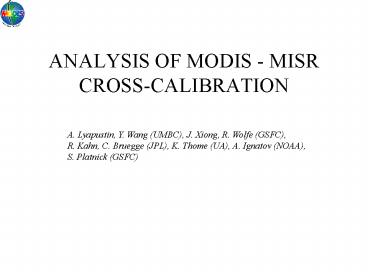ANALYSIS OF MODIS - MISR CROSS-CALIBRATION PowerPoint PPT Presentation
1 / 8
Title: ANALYSIS OF MODIS - MISR CROSS-CALIBRATION
1
ANALYSIS OF MODIS - MISR CROSS-CALIBRATION
A. Lyapustin, Y. Wang (UMBC), J. Xiong, R. Wolfe
(GSFC), R. Kahn, C. Bruegge (JPL), K. Thome
(UA), A. Ignatov (NOAA), S. Platnick (GSFC)
2
AERONET-based Surface Reflectance Validation
Network (ASRVN)
A. Lyapustin, Y. Wang (GEST UMBC/NASA GSFC), B.
Holben, J. Privette (GSFC)
- Goal development of globally representative
dataset of surface reflectance - Surface BRF and albedo are important EOS
products, not yet validated globally. - Knowledge of SR is required by CM, cloud
properties, and aerosol algorithms.
- THEORETICAL BASIS
- 3D Radiative Transfer (Lyapustin Knyazikhin,
Appl. Opt., 2001 2002) - variable anisotropic surface
- arbitrary spatial resolution
- semi-analytical, accurate and fast due to
parameterizations. - Accurate Modeling of Gaseous Absorption
- Inversion with MRPVMISR and LSRTMODIS BRF Models
- PRODUCTS
- BRF, Albedo (spectral SW broadband)
- Surface Radiative Fluxes, PAR
- Spectral Regression Coefficients (2.1 ?m?Blue,
Red) - APPLICATIONS
- Validation of BRF Albedo over Heterogeneous
Surfaces - Calibration Analysis
- Vicarious calibration
- Cross-calibration of different sensors
- Detection of calibration trend based on a time
series of surface reflectance (climate quality).
MISR MODIS ETM
VIIRS
3
Cross-Calibration Analysis
Comparison of MISR (top) and MODIS TERRA (bottom)
ASRVN albedo over Mongu, Zambia
4
MODIS vs MISR Albedo cont. (GSFC, USA)
Artifacts of measurements
Cloudy pixels
5
Regression of TOA Reflectance (35?35 km2, gt50
cloudy)
6
Band-pass functions of MISR (red) and MODIS land
(blue) spectral channels
Simulation Model
- SHARM_IPC_Mie code
- arbitrary band-pass function (MISR MODIS
VIIRS ETM) - absorption of 7 major atmospheric gases (H2O,
CO2, O3, CH4, NO2, CO, N2O) LBL absorption is
modeled using HITRAN-2000 database and Voigt
profile, continuum absorption model of AER
(Clough et al.) - atmospheric profiles of Standard Models, solar
irradiance model of Kurucz (MODTRAN3.0) - spectral resolution 0.01 1 cm-1
- full multiple scattering RT (code SHARM) with
exactly calculated single scattering, Delta-M
method for clouds - Aerosol (Mie) model
- bi-modal log-normal size distribution
(urban-industrial, biomass burning, dust/maritime
models from Dubovik et al., 2002). - Surface models
- spectral albedo from ASTER and USGS spectral
libraries - Water cloud models
- log-normal size distribution, r6, 10, 15, 20
?m, ?0.1 ?m ?c3.7 130.
7
Simulated Regression of TOA Reflectance for Water
Clouds
Table 1. Dependence of slope on droplet size.
Simulations were done with Hc2km, RH2cm, 1976
US Standard Atmospheric Profile.
Table 2. Effect of cloud top height and column
water vapor on the slope of regression.
8
Summary
AB BB AG BG AR BR ANir BNir
1. Measured (151 points) 1.0466 0.0135 1.0256 0.002 1.0534 -0.0002 1.0092 0.0005
2. Simulated 0.989 0.0043 0.995 -0.0001 1.041 0.0007 1.009 0.0007
3. Difference 0.0577 0.0092 0.0306 0.002 0.0124 0.000 0.000 0.000
Table 3. Summary of regression coefficients
Conclusions
- We developed two independent methods to evaluate
calibration bias between MODIS TERRA and MISR - The first one derives bias as a difference
between observed and theoretical regression
coefficients for the TOA reflectance. - The second one evaluates bias based on
statistical matching of the ASRVN albedo products
from MODIS and from MISR over a large number of
AERONET sites. The estimates from both methods
agree well, except in the red band, where the
albedo matching technique predicts about twice as
high difference. - Conclusions for the first method
- Clouds prove to be a reliable stable target for
the cross-calibration analysis. - Comparison of MODIS-MISR regression lines
obtained from measurements and from simulations
allows to evaluate the difference in the gain
coefficient. - Our analysis suggests the following band gain
difference Blue 5.8, Green 3.1, Red
1.2.

